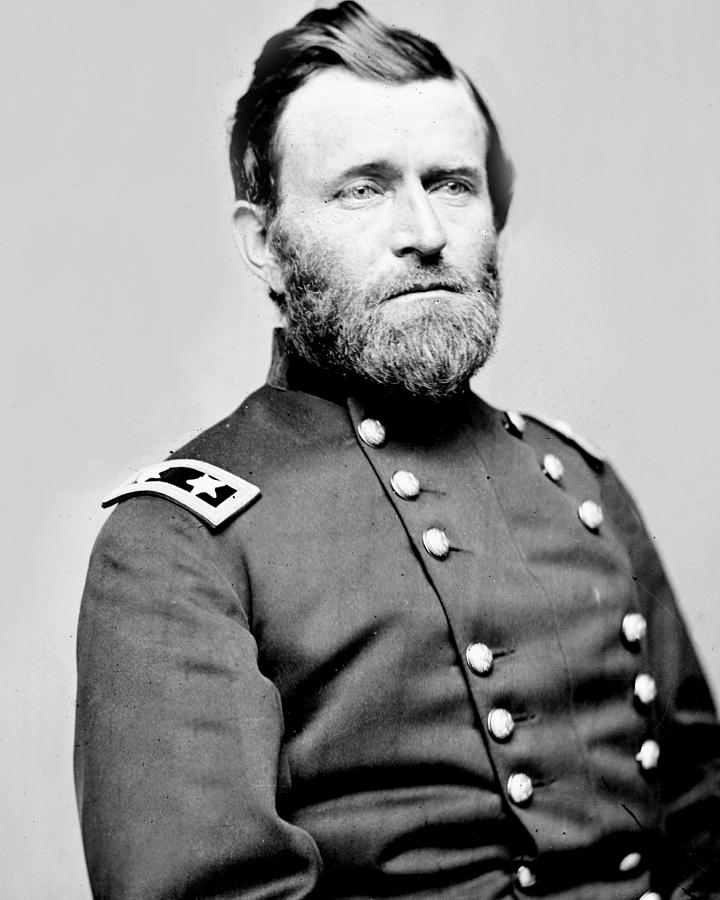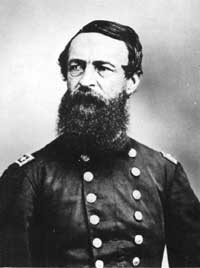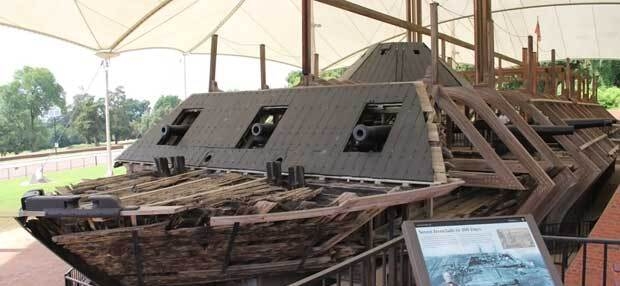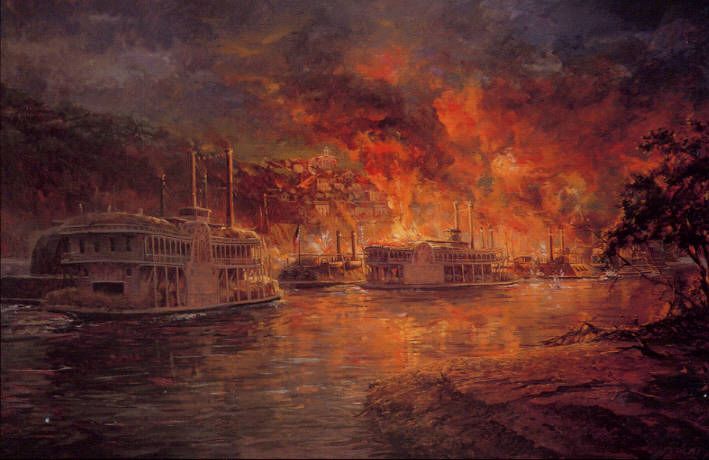By Daniel J. Ursu, Roundtable Historian
The Cleveland Civil War Roundtable
Copyright © 2020-2021, All Rights Reserved
Editor’s note: This article was the history brief for the November 2020 meeting of the Cleveland Civil War Roundtable.
We resume where we left off in October with General Grant having decided to move ahead with Admiral Porter’s daring plan to help achieve Grant’s goal of ultimately landing troops on dry ground on the east bank of the Mississippi south of Vicksburg. Porter’s plan was to slip by fortress Vicksburg “running the batteries” under the cover of darkness. However, before we venture further, one of our members, Brian Kowell, after reading last month’s history brief submitted some additional research to me on the ironclads in Porter’s fleet that I believe readers of this history brief would enjoy.

Ulysses S. Grant 
David Dixon Porter
Please recall from last month that four river ironclads of the “City Class,” also known as the “Cairo Class,” and lastly also known as “Pook’s Turtles” after the name of their designer would make up a substantial portion of the fleet, namely the Louisville, Mound City, Pittsburg, and Carondolet. The sister ships were identically constructed and armed but were fascinatingly differentiated by multi-colored rings painted on the smokestacks of each ship. Further, although by the time of this engagement various armaments had been modified as to type and caliber, Brian’s research shows that they each still carried 13 guns.

For readers who have visited Vicksburg, you know that the Cairo, also one of “Pook’s Turtles,” was sunk in the Yazoo River on December 12, 1862 by Confederates employing an electronically detonated mine. This is widely thought to be the first vessel in naval history to be sunk by such a device. About 100 years later the Cairo was dredged up, under the direction of Edwin C. Bearss, former Chief Historian of the National Park Service. Mr. Bearss spoke at our Roundtable numerous times and for the final time at our Roundtable on December 12, 2018 during my CCWRT presidential year. May Mr. Bearss Rest in Peace. Further, under his direction, the Cairo was refurbished and put on display in Vicksburg. Brian Kowell was able to research the precise armament found at the wreckage of the Cairo in the early 1960’s:
- 8-inch Navy gun with carriage, salvaged 9/14/1960, loaded with canister
- 30 pounder Naval Parrot rifle, salvaged 10/20/1963, loaded with explosive shell (against regulations)
- 32 pounder smoothbore, salvaged 10/20/1963, not loaded, presumably had just been fired
- 8-inch Navy gun, salvaged 10/25/1963, loaded with double charge of canister
- 42 pounder rifle (originally smoothbore but had been rifled), salvaged 10/27/1963, port bow gun loaded with explosive shell filled with shrapnel
- 42 pounder rifle, salvaged 10/27/1963, starboard bow gun loaded with 87-pound explosive shell
- 32 pounder smoothbore, salvaged 10/27/1963, no. 1 port gun double loaded with canister, its tube dismounted from torpedo explosion
- 42 pounder rifle, salvaged 10/31/1963, no. 1 starboard gun loaded with 87-pound explosive shell
- 8-inch Navy gun, salvaged 11/6/1963, no. 3 port gun loaded with grape
- 32 pounder smoothbore, salvaged 11/6/1963, no. 3 port gun
- 32 pounder smoothbore, salvaged 11/1963, no. 4 port gun loaded with solid shot
- 32 pounder smoothbore, salvaged 11/6/1963, no. 4 starboard gun
- 32 pounder smoothbore, salvaged 11/6/1963, stern starboard gun
When Mr. Bearss was here in 2018, he mentioned that his first visit to our Roundtable was during the Kennedy Administration’s Cuban Missile Crisis in October of 1962. So at the time of his initial visit, Mr. Bearss was actively working on the Cairo dredging project. How impressed our members must have been at that time to hear all about it!

Having digressed, let’s go back to 1863. Accordingly, four of Cairo’s sister ships and other vessels were assembled in Admiral Porter’s flotilla on the evening of April 16, 1863. They were floating in the Mississippi River north of Vicksburg and configured in a line bow to stern about 150 feet apart. Each captain was to steer slightly leftward to avoid the ship ahead should it become disabled once the fleet proceeded and came under fire.
Ironclad Benton was at the head of the van. She was lashed to the tug Ivy, followed by ironclad Lafayette, which was lashed to General Price. Thence came ironclads Louisville, Mound City, Pittsburgh, and Carondolet followed by three army transports and finally the ironclad Tuscumbria. To ensure surprise, the attempt to run the batteries would be made at night sans lighting except what was needed for signaling purposes. That illumination was shielded under hooded lanterns that would not be visible to Confederate cannoneers. The van would move at low speed until sighted to keep engine noise to a minimum; they would essentially depend on the mighty river’s strong current to advance.
Anchors were weighed in at about 10:30 p.m. under a clear, star-filled night. At this very moment, General Pemberton, the Confederate commander at Vicksburg, his officers, and townsfolk were at a dance celebrating recent events that they misinterpreted as a retreat by Grant. How better to describe what happened next during arguably the most pivotal moment of the Civil War than to turn to the eyewitness account of General Grant, himself, from his Memoirs:
“Soon after the start a battery between Vicksburg and Warrenton opened fire across the intervening peninsula, followed by the upper batteries, and then by batteries all along the line. The gunboats ran up close under the bluffs, delivering their fire in return at short distances, probably without much effect. They were under fire for more than two hours and every vessel was struck many times, but with little damage to the gunboats. The transports did not fare so well. The Henry Clay was disabled and deserted by her crew. Soon after a shell burnt in the cotton packed about the boilers, set the vessel on fire and burned her to the water’s edge. The burning mass, however, floated down to Carthage before grounding, as did also one of the barges in tow. The enemy were evidently expecting our fleet, for they were ready to light up the river by means of bonfires on the east side and by firing houses on the point of land opposite the city on the Louisiana side. The sight was magnificent, but terrible. I witnessed it from the deck of a river transport, run out into the middle of the river and as low down as it was prudent to go. My mind was much relieved when I learned that no one on the transports had been killed and but few, if any, wounded. During the running of the batteries men were stationed in the holds of the transports to partially stop with cotton shot-holes that might be made in the hulls. All damage was afterwards soon repaired under the direction Admiral Porter.”

The Union broadsides, unleashed in response to the South’s plunging fire from positions on the east bank bluffs of the Mississippi, were blindly fired toward the Confederate batteries above to no avail. Conversely, about 530 rounds were fired by the rebel batteries, of which about 70 found targets. Porter later in a private letter indicated that he incurred heavier damage than mentioned in the official reports stating: “as it will not do to let the enemy know how often they hit us, and show how vulnerable we are. Their heavy shot walked right through us as if we were made of putty.” Nevertheless, the venture was a resounding success with all of the ironclads and two of three transports making it successfully past the fortress at the human cost of 14 wounded men. In the meantime, Grant had ordered Sherman to deceive General Pemberton with a feint along the Yazoo River to coerce him into thinking that a major Union attack would be mounted from north of Vicksburg.

Further, Grant ordered cavalry Colonel Benjamin Grierson, a former music teacher, composer, and abolitionist, whose formative years were spent in Youngstown, Ohio, to depart with three regiments of cavalry to raid central Mississippi. The purpose of the raid was to destroy rebel communications, supplies, and munitions and to generally create havoc. Grierson’s rampage went on for 16 days from April 16 to May 2. His 1,700 troopers of the heretofore often maligned Union cavalry performed a raid that was among the most successful use of cavalry by either side during the entire war. As some termed it, Grierson’s cavalry rode “Roughshod through Dixie” and not only did they destroy all manner of extremely hard to replace southern goods, they also drew thousands of rebel troops away from Tennessee, Alabama, Louisiana, and Mississippi, soldiers that were consequently woefully out of position to counter Grant’s soon to be launched attack on Vicksburg. Also of importance, according to Sergeant Surby, one of Grierson’s ablest and most distinguished scouts, the troopers “played smash with the railroads.” For example, the damage wrought to the New Orleans, Jackson and Great Northern Railroad was so thorough that it was rendered useless for the remainder of the war. In sum, the raid spectacularly augmented Grant’s campaign both materially and strategically.
On April 20, with the fleet below Vicksburg, Grant’s immediate goal was within grasp as he wrote the open-ended order for his command to “obtain a foothold on the east bank of the Mississippi River, from which Vicksburg can be approached by practicable roads.” General McLernand thusly was in motion with three corps marching southward along the west bank of the Mississippi. They were to rendezvous with Porter’s fleet in anticipation of being transported to the east bank in the vicinity of Grand Gulf about 25 miles as the crow flies south of Vicksburg.
Now Grant was orchestrating and bringing heavily to bear on the unwitting Confederate General Pemberton the full might of the combined arms resources of the Union’s infantry, cavalry, and navy in that part of the Western Theater of war. Truly a man of vitality and confidence, any notion of Catton’s “slouchy little man” from This Hallowed Ground leading up to April 1863 was now cast asunder. One of Grant’s officers at this juncture wrote about Grant, “None who had known him the previous years could recognize him as being the same man…From this time his genius and his energies seemed to burst forth with new life.”
While probably not quite yet the Civil War’s “indispensable man,” we will track Grant’s next steps toward earning that sobriquet in December’s history brief. We will see Union troops endeavor a military crossing of the Mississippi River in enemy territory and watch Grant begin to explore for those “practicable roads”!
Related links:
Grant’s Winter of 1862-3: Three Attempts at Vicksburg (September 2020 history brief)
Grant’s Combined Arms Generalship at Vicksburg – Part I (October 2020 history brief)
Grierson’s Raid
